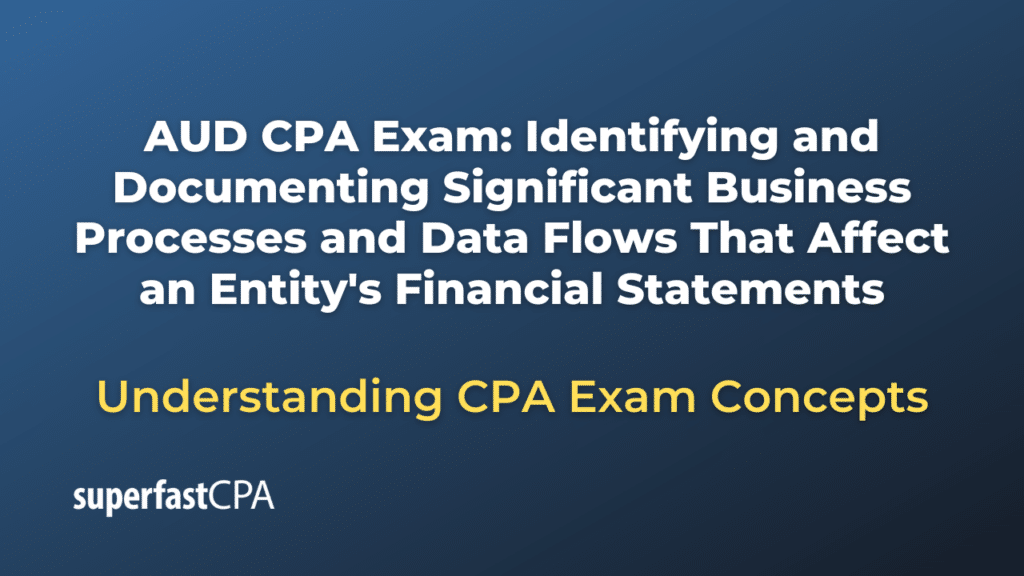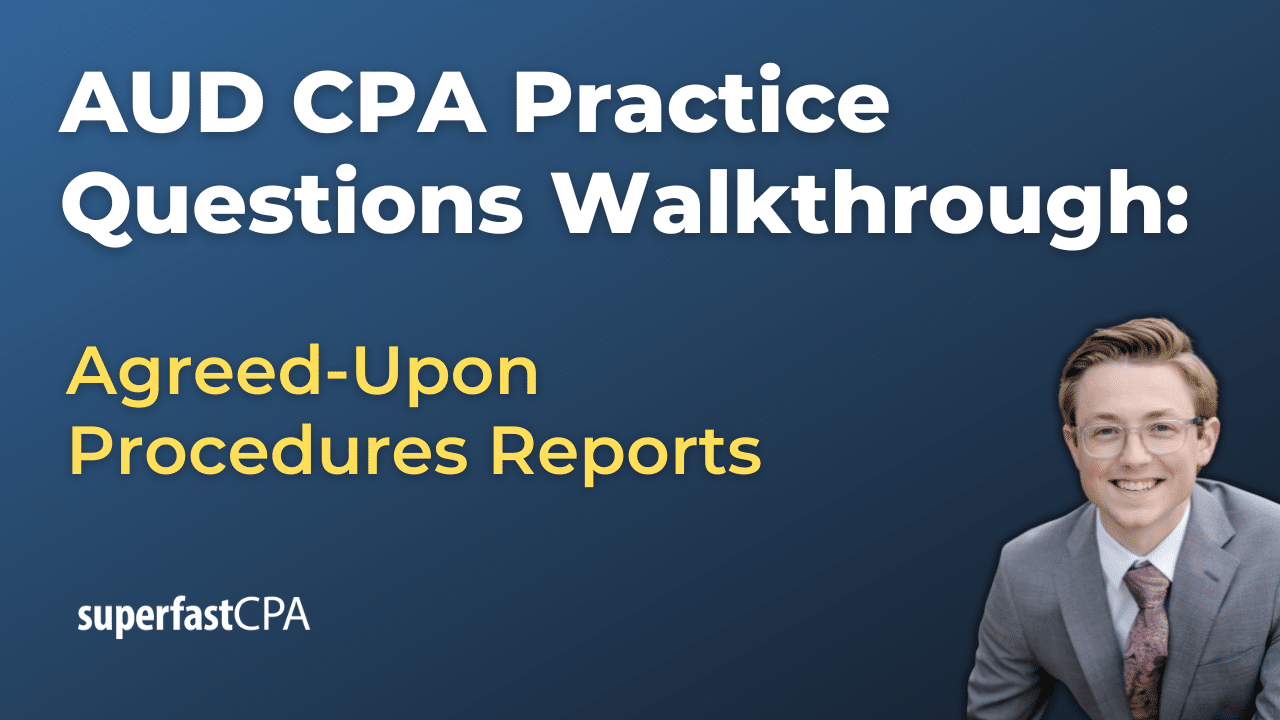Introduction
Importance of Understanding Business Processes and Data Flows in the Context of Financial Statements
In this article, we’ll cover identifying and documenting significant business processes and data flows that affect an entity’s financial statements. In the realm of financial accounting and reporting, a thorough understanding of business processes and data flows is paramount. Business processes encompass the series of activities and tasks that produce a specific service or product for customers. These processes, whether they involve revenue generation, procurement, inventory management, payroll, or financial reporting, directly affect an entity’s financial statements.
Data flows refer to the movement of data within these processes—from data input and processing to data output. Accurate data flows ensure that the financial information captured is complete, accurate, and timely. This information is crucial for producing reliable financial statements that reflect the true financial position and performance of an entity.
Understanding business processes and data flows enables accountants and auditors to:
- Identify areas where errors or fraud could occur.
- Implement and evaluate internal controls to mitigate these risks.
- Ensure compliance with regulatory requirements and accounting standards.
- Provide a solid foundation for internal and external audits.
- Enhance operational efficiency and effectiveness through improved process management.
A deep grasp of these concepts ensures that the financial statements are not only accurate but also provide a fair representation of the entity’s operations, thereby supporting stakeholders in making informed decisions.
The importance of understanding business processes and data flows extends beyond exam preparation. It forms the bedrock of accurate financial reporting, robust internal controls, and effective risk management, all of which are critical to the accounting profession.
Understanding Business Processes
Definition of Business Processes
A business process is a series of interconnected activities or tasks that are designed to achieve a specific organizational goal. These processes are the building blocks of how businesses operate, manage resources, and deliver value to customers. Each process typically involves a sequence of steps that convert inputs (such as raw materials, information, or labor) into outputs (such as products, services, or financial reports).
Business processes can be simple or complex, depending on the nature and scale of the organization. They are often documented in procedures and workflows to ensure consistency, efficiency, and effectiveness. Understanding and managing business processes is crucial for maintaining operational integrity and achieving strategic objectives.
Types of Business Processes
Business processes can be categorized into three main types: operational, management, and support processes.
Operational Processes
Operational processes, also known as primary or core processes, are directly related to the creation of products or services that deliver value to customers. These are the fundamental activities that define the primary mission of the business. Examples of operational processes include:
- Sales and Revenue Generation: Activities involved in selling products or services, from customer inquiries to order fulfillment.
- Procurement and Supply Chain Management: Processes for acquiring raw materials, components, and services needed for production.
- Production and Manufacturing: Steps involved in transforming raw materials into finished goods.
- Customer Service and Support: Activities aimed at ensuring customer satisfaction and resolving issues.
Management Processes
Management processes are the activities related to planning, monitoring, and controlling the operations of a business. These processes ensure that the organization’s goals are met efficiently and effectively. Examples of management processes include:
- Strategic Planning: Setting long-term goals and determining the best approach to achieve them.
- Budgeting and Forecasting: Allocating resources and predicting future financial performance.
- Performance Management: Monitoring and evaluating employee and organizational performance.
- Risk Management: Identifying, assessing, and mitigating risks to the business.
Support Processes
Support processes, also known as secondary processes, provide the necessary support to the operational and management processes. While they do not directly deliver value to customers, they are essential for the smooth functioning of the organization. Examples of support processes include:
- Human Resources Management: Recruiting, training, and managing employees.
- Information Technology Services: Maintaining and supporting the organization’s technology infrastructure.
- Finance and Accounting: Managing financial transactions, reporting, and compliance.
- Legal and Compliance: Ensuring that the organization adheres to laws, regulations, and internal policies.
Role of Business Processes in Financial Reporting
Business processes play a critical role in financial reporting by ensuring that financial information is accurate, complete, and timely. Each process generates data that feeds into the financial statements, influencing how an organization’s financial health and performance are presented.
Key roles of business processes in financial reporting include:
- Data Collection and Recording: Business processes capture financial data from various activities, such as sales, purchases, payroll, and production. Accurate recording of this data is crucial for generating reliable financial statements.
- Internal Controls: Effective business processes incorporate internal controls that help prevent errors and fraud. These controls ensure that financial transactions are authorized, recorded correctly, and reviewed periodically.
- Compliance and Regulation: Business processes must comply with accounting standards, tax laws, and regulatory requirements. Adhering to these standards ensures that financial reports are consistent, comparable, and transparent.
- Financial Analysis and Decision-Making: Well-defined business processes provide a clear and consistent basis for financial analysis. This allows management to make informed decisions based on accurate financial information.
- Audit and Assurance: Documented business processes and data flows facilitate internal and external audits. Auditors rely on these documents to verify the accuracy and integrity of the financial statements.
Understanding and optimizing business processes are essential for producing reliable financial reports, maintaining compliance, and achieving overall organizational success. For CPA exam candidates, mastering these concepts is vital for both exam success and practical application in their professional careers.
Identifying Significant Business Processes
Criteria for Determining Significance
Identifying significant business processes is a critical task for accountants and auditors, as it ensures that the financial statements accurately reflect the entity’s operations and financial position. The significance of a business process can be determined based on several criteria, which include its impact on financial statements, the volume and complexity of transactions it handles, and its susceptibility to fraud and errors.
Impact on Financial Statements
The primary criterion for determining the significance of a business process is its impact on the financial statements. Significant business processes are those that have a direct and substantial effect on key financial statement elements such as revenues, expenses, assets, and liabilities. For example, the sales and revenue process is often considered significant because it directly affects the income statement and, consequently, the entity’s profitability.
When evaluating the impact on financial statements, consider the following:
- Materiality: Processes that handle large volumes of transactions or high-value items that can materially affect the financial statements are significant.
- Frequency: Processes that occur frequently and regularly contribute substantially to the financial data captured in the financial statements.
- Accounting Adjustments: Processes that involve complex accounting adjustments or estimations, such as inventory valuation or depreciation, are significant due to their potential impact on reported financial outcomes.
Volume and Complexity of Transactions
Another important criterion is the volume and complexity of transactions processed by the business process. High-volume processes that handle numerous transactions daily are significant because errors or inefficiencies in these processes can accumulate and lead to substantial misstatements in the financial statements.
Complex processes, on the other hand, involve multiple steps, systems, or decision points, which increase the risk of errors or inconsistencies. For example, the procurement process in a large manufacturing firm may involve various departments, approvals, and systems, making it both high-volume and complex.
Key aspects to consider regarding volume and complexity include:
- Transaction Volume: Processes that manage a large number of transactions, such as accounts payable or payroll, require rigorous controls and documentation due to the sheer volume of data.
- Process Complexity: Complex processes with multiple steps, integrations with other systems, or significant manual interventions need detailed documentation and control mechanisms to ensure accuracy.
- Interdependencies: Processes that are heavily interdependent with other processes or systems can introduce complexity and require careful coordination and oversight.
Susceptibility to Fraud and Errors
The susceptibility of a business process to fraud and errors is a crucial factor in determining its significance. Processes that handle cash transactions, sensitive data, or high-value assets are particularly vulnerable to fraud and errors. Ensuring robust controls and monitoring mechanisms for these processes is essential to mitigate risks.
Factors that influence susceptibility include:
- Cash Handling: Processes involving cash receipts or disbursements are highly susceptible to fraud due to the liquidity and attractiveness of cash. Examples include the cash sales process and the petty cash process.
- Sensitive Data: Processes that handle sensitive information, such as customer data or financial records, require stringent controls to prevent unauthorized access and data breaches.
- High-Value Transactions: Processes involving high-value transactions, such as capital expenditures or large vendor payments, are at higher risk for fraudulent activities and require thorough review and approval mechanisms.
- Manual Interventions: Processes that rely heavily on manual inputs are more prone to human errors and manipulation, making them significant from a control perspective.
Determining the significance of a business process involves evaluating its impact on the financial statements, the volume and complexity of the transactions it handles, and its susceptibility to fraud and errors. Understanding these criteria helps accountants and auditors focus their efforts on the most critical areas, ensuring accurate and reliable financial reporting. For CPA exam candidates, mastering the identification of significant business processes is essential for both exam success and practical application in their professional roles.
Identifying Significant Business Processes
Common Significant Business Processes
Certain business processes are commonly identified as significant due to their substantial impact on an entity’s financial statements. Understanding these processes is crucial for accurate financial reporting and effective auditing. The following are key examples of significant business processes:
Revenue and Sales
The revenue and sales process encompasses all activities related to generating income from the sale of goods or services. This process is significant because it directly affects the income statement and the entity’s profitability. Key components of the revenue and sales process include:
- Order Processing: Receiving and processing customer orders.
- Invoicing: Issuing invoices to customers for goods or services rendered.
- Revenue Recognition: Recording revenue in accordance with applicable accounting standards.
- Cash Collection: Receiving payments from customers.
- Returns and Allowances: Handling product returns and granting allowances or discounts.
Proper documentation and control over the revenue and sales process are essential to ensure accurate revenue reporting and compliance with revenue recognition principles.
Procurement and Expenditures
The procurement and expenditures process involves acquiring goods and services necessary for the entity’s operations and managing the related expenditures. This process significantly impacts both the balance sheet (through accounts payable and inventory) and the income statement (through expenses). Key components include:
- Supplier Selection: Evaluating and selecting suppliers.
- Purchase Orders: Issuing purchase orders for goods and services.
- Receiving Goods and Services: Verifying and accepting deliveries.
- Invoice Processing: Reviewing and approving supplier invoices.
- Payment Processing: Issuing payments to suppliers.
Effective management of the procurement and expenditures process ensures that purchases are authorized, properly recorded, and paid in a timely manner, thereby maintaining accurate financial records.
Inventory Management
Inventory management involves tracking and controlling the entity’s inventory levels, from procurement to sale. This process is significant due to its impact on the cost of goods sold, gross profit, and overall financial position. Key components include:
- Inventory Purchasing: Acquiring raw materials, components, or finished goods.
- Inventory Storage: Managing the storage and handling of inventory.
- Inventory Tracking: Monitoring inventory levels and movements.
- Inventory Valuation: Valuing inventory using methods such as FIFO, LIFO, or weighted average.
- Inventory Reconciliation: Comparing physical inventory counts with recorded amounts.
Accurate inventory management is critical to ensure that inventory is properly valued and reported, preventing misstatements in financial statements.
Payroll and Human Resources
The payroll and human resources process encompasses all activities related to managing employee compensation and benefits. This process is significant because it affects the entity’s labor costs, which are often a major expense on the income statement. Key components include:
- Employee Records: Maintaining employee information and records.
- Timekeeping: Tracking employee hours worked.
- Payroll Processing: Calculating and disbursing employee wages and salaries.
- Benefits Administration: Managing employee benefits, such as health insurance and retirement plans.
- Compliance and Reporting: Ensuring compliance with labor laws and tax regulations, and preparing related reports.
Proper control over the payroll and human resources process ensures accurate calculation and timely payment of wages, as well as compliance with legal and regulatory requirements.
Financial Closing and Reporting
The financial closing and reporting process involves finalizing the financial records at the end of a reporting period and preparing the financial statements. This process is significant because it ensures the accuracy and completeness of the financial statements, which stakeholders rely on for decision-making. Key components include:
- General Ledger Maintenance: Recording and maintaining general ledger accounts.
- Account Reconciliation: Reconciling accounts to ensure accuracy.
- Adjusting Entries: Making necessary adjustments, such as accruals and deferrals.
- Financial Statement Preparation: Compiling the income statement, balance sheet, statement of cash flows, and other financial reports.
- Internal and External Reporting: Preparing and distributing financial reports to management, investors, regulators, and other stakeholders.
The financial closing and reporting process is essential for producing reliable financial statements that reflect the true financial position and performance of the entity.
Identifying significant business processes, such as revenue and sales, procurement and expenditures, inventory management, payroll and human resources, and financial closing and reporting, is crucial for accurate financial reporting and effective auditing. For CPA exam candidates, understanding these processes is vital for both exam success and practical application in their professional careers.
Understanding Data Flows
Definition and Importance of Data Flows
Data flows refer to the movement and transformation of data within and between business processes. This concept encompasses how data is captured, processed, stored, and transmitted across various systems and departments. Understanding data flows is crucial for ensuring the accuracy, completeness, and reliability of financial information.
The importance of data flows lies in their role in:
- Ensuring Data Integrity: Accurate data flows prevent errors and inconsistencies in financial reporting.
- Facilitating Decision-Making: Reliable data supports informed decision-making by management and stakeholders.
- Supporting Compliance: Properly managed data flows ensure compliance with regulatory requirements and accounting standards.
- Enhancing Efficiency: Streamlined data flows improve operational efficiency and reduce the risk of data bottlenecks.
Relationship Between Business Processes and Data Flows
Business processes and data flows are intrinsically linked. Every business process involves the generation, processing, and utilization of data. Data flows represent the pathways through which information travels within these processes, facilitating the completion of tasks and activities.
For example, in the revenue and sales process:
- Data Input: Customer order details are captured and entered into the system.
- Processing Activity: The order is processed, inventory levels are updated, and an invoice is generated.
- Data Output: The invoice is sent to the customer, and the transaction is recorded in the financial system.
Understanding the relationship between business processes and data flows helps in identifying critical points where data integrity must be maintained, and controls need to be implemented.
Key Elements of Data Flows
Data flows consist of several key elements that ensure the smooth movement and transformation of data within business processes. These elements include data inputs, processing activities, and data outputs.
Data Inputs
Data inputs are the raw data or information that enters a business process. They serve as the starting point for any process and are critical for initiating subsequent activities. Examples of data inputs include:
- Customer orders
- Supplier invoices
- Employee time sheets
- Inventory receipts
Accurate and complete data inputs are essential for the integrity of the entire data flow and the reliability of the resulting financial information.
Processing Activities
Processing activities involve the transformation of data inputs into meaningful information through various operations and tasks. These activities are the core of the data flow and include:
- Data Entry: Inputting data into information systems.
- Data Validation: Checking data for accuracy and completeness.
- Data Transformation: Converting data into a different format or structure.
- Data Calculation: Performing calculations and aggregations.
- Data Storage: Saving data in databases or other storage systems.
Effective processing activities ensure that data is accurately captured, transformed, and stored, supporting reliable financial reporting.
Data Outputs
Data outputs are the final results produced by processing activities. They represent the culmination of the data flow and are used for decision-making, reporting, and further processing. Examples of data outputs include:
- Financial statements
- Customer invoices
- Management reports
- Regulatory filings
Accurate and timely data outputs are crucial for providing stakeholders with reliable information and ensuring compliance with reporting requirements.
Understanding data flows involves recognizing the importance of data movement within business processes, the relationship between these processes and data flows, and the key elements that constitute data flows. For CPA exam candidates, mastering these concepts is essential for ensuring the accuracy and reliability of financial reporting and for performing effective audits.
Documenting Business Processes and Data Flows
Objectives of Documentation
Documenting business processes and data flows is a critical activity that serves several essential objectives. Proper documentation ensures that all stakeholders have a clear and accurate understanding of how business processes operate and how data moves through these processes. The primary objectives of documentation include:
Ensuring Accuracy and Completeness of Financial Statements
Accurate documentation helps in maintaining the integrity of financial data by clearly defining how transactions are processed and recorded. This ensures that financial statements accurately reflect the entity’s financial position and performance. Detailed documentation provides a roadmap for how data is captured, processed, and reported, minimizing the risk of errors and omissions in the financial statements.
Supporting Internal and External Audits
Comprehensive documentation is invaluable for both internal and external audits. Auditors rely on documented processes and data flows to understand the entity’s operations and assess the effectiveness of internal controls. Proper documentation allows auditors to trace transactions from their origin to their final reporting, ensuring that financial statements are free from material misstatements. Additionally, it helps in identifying areas of potential risk and control weaknesses.
Facilitating Internal Controls and Risk Management
Effective documentation of business processes and data flows is essential for implementing and maintaining robust internal controls. It provides a framework for identifying critical control points and ensures that these controls are properly designed and operating effectively. Documentation also plays a key role in risk management by helping organizations identify and mitigate potential risks associated with their business processes and data flows.
Techniques for Documenting Processes and Flows
Several techniques can be employed to document business processes and data flows. Each technique has its strengths and is suitable for different aspects of process documentation. The most commonly used techniques include flowcharts, narrative descriptions, data flow diagrams, and system documentation.
Flowcharts
Flowcharts are visual representations of business processes that use symbols and arrows to depict the sequence of activities and the flow of data. They provide a clear and concise overview of the process steps, decision points, and interactions between different components of the process. Flowcharts are particularly useful for identifying bottlenecks, inefficiencies, and control points within a process.
Advantages of Flowcharts:
- Easy to understand and interpret
- Highlight the sequence and interaction of activities
- Useful for identifying control points and potential improvements
Narrative Descriptions
Narrative descriptions provide a detailed, written account of business processes and data flows. They describe each step of the process, including who performs the task, how it is performed, and what data is used or produced. Narrative descriptions are valuable for providing a comprehensive understanding of complex processes and for documenting processes that may not be easily visualized through flowcharts.
Advantages of Narrative Descriptions:
- Provide detailed and comprehensive information
- Useful for complex processes with multiple variations
- Offer context and background information
Data Flow Diagrams
Data flow diagrams (DFDs) are graphical representations that depict the flow of data within a system. They show how data moves from inputs to processing activities to outputs and highlight the interactions between different data sources, processes, and data storage. DFDs are particularly useful for understanding how data is handled and transformed within an information system.
Advantages of Data Flow Diagrams:
- Focus on data movement and transformation
- Clarify the relationships between data inputs, processes, and outputs
- Useful for analyzing and improving data handling procedures
System Documentation
System documentation involves detailed descriptions of the information systems and software applications used to support business processes. This documentation includes system architecture, data structures, user manuals, and technical specifications. System documentation is essential for ensuring that systems are used correctly and efficiently and for supporting system maintenance and upgrades.
Advantages of System Documentation:
- Provides detailed technical information about systems and applications
- Supports system maintenance, troubleshooting, and upgrades
- Ensures that users understand how to operate and interact with systems
Documenting business processes and data flows is essential for ensuring the accuracy and completeness of financial statements, supporting audits, and facilitating internal controls and risk management. Techniques such as flowcharts, narrative descriptions, data flow diagrams, and system documentation provide valuable tools for capturing and communicating how processes and data flows operate within an organization. For CPA exam candidates, mastering these documentation techniques is crucial for both exam success and practical application in their professional careers.
Steps for Identifying and Documenting Processes and Data Flows
Conducting a Process Walkthrough
A process walkthrough is the initial step in identifying and documenting business processes and data flows. This step involves gaining a thorough understanding of how processes function by interacting with key personnel, reviewing existing documentation, and observing processes in action.
Interviewing Key Personnel
Interviewing key personnel is crucial for gaining insights into the actual workings of business processes. These interviews should include:
- Process Owners: Individuals responsible for overseeing the process.
- Operators: Staff members who perform day-to-day tasks within the process.
- Support Staff: Employees who provide administrative or technical support.
By conducting interviews, you can gather detailed information about each step of the process, understand the rationale behind specific procedures, and identify any pain points or areas for improvement.
Reviewing Existing Documentation
Reviewing existing documentation provides a foundation for understanding current processes. This documentation can include:
- Standard Operating Procedures (SOPs): Detailed instructions on how tasks are performed.
- Process Maps: Visual representations of the process flow.
- Previous Audit Reports: Insights into past assessments and identified issues.
Existing documentation helps to identify discrepancies between documented procedures and actual practices, which can be addressed during the process mapping phase.
Observing Processes in Action
Observing processes in action offers a real-time perspective on how tasks are performed. This step involves:
- Shadowing Employees: Watching staff members as they perform their tasks.
- Recording Observations: Taking detailed notes on each step, any variations, and potential bottlenecks.
- Identifying Informal Practices: Noting any unofficial shortcuts or workarounds used by employees.
Observation helps to validate information gathered from interviews and documentation, ensuring a comprehensive understanding of the process.
Mapping Out Processes
Once a thorough understanding of the processes has been achieved through walkthroughs, the next step is to map out these processes. This involves creating visual representations and detailed descriptions of each process and its associated data flows.
Identifying Start and End Points
The first step in mapping out processes is to identify the start and end points. This involves:
- Start Point: The initial trigger or input that begins the process.
- End Point: The final output or outcome of the process.
Clear start and end points help to define the scope of the process and ensure that all relevant steps are included in the documentation.
Documenting Each Step and Associated Data Flow
Documenting each step of the process involves detailing all activities and their associated data flows. This includes:
- Process Steps: Each action or task performed within the process.
- Data Inputs: Information or materials required to perform each step.
- Processing Activities: How data is transformed or processed at each step.
- Data Outputs: Results or outcomes produced by each step.
Detailed documentation ensures that every aspect of the process is captured, facilitating accurate analysis and reporting.
Highlighting Control Points and Potential Risks
Highlighting control points and potential risks involves identifying areas where controls are implemented to ensure accuracy and mitigate risks. This includes:
- Control Points: Steps where checks, approvals, or validations are performed.
- Risk Areas: Steps that are susceptible to errors, fraud, or inefficiencies.
Documenting control points and risks helps to strengthen internal controls and improve process reliability.
Verifying and Validating Documentation
The final step in identifying and documenting processes and data flows is to verify and validate the documentation. This ensures that the documented processes accurately reflect actual practices and are complete and reliable.
Reviewing with Process Owners
Reviewing documentation with process owners involves:
- Feedback: Gathering feedback from process owners on the accuracy and completeness of the documentation.
- Clarifications: Addressing any ambiguities or discrepancies identified by process owners.
- Approval: Obtaining formal approval from process owners for the documented processes.
This step ensures that the documentation is accurate and endorsed by those responsible for the process.
Testing for Accuracy and Completeness
Testing the documented processes involves:
- Walkthroughs: Conducting walkthroughs based on the documentation to ensure it accurately reflects actual practices.
- Sample Testing: Testing a sample of transactions or activities to verify that the documentation captures all necessary steps and data flows.
- Validation: Ensuring that all control points and risk areas are properly identified and addressed.
Testing helps to confirm that the documentation is thorough and reliable, supporting effective process management and financial reporting.
Identifying and documenting processes and data flows involves conducting process walkthroughs, mapping out processes, and verifying and validating documentation. For CPA exam candidates, mastering these steps is crucial for ensuring accurate financial reporting and effective auditing in their professional careers.
Common Challenges and Best Practices
Challenges in Identifying and Documenting Processes
Identifying and documenting business processes and data flows can be challenging due to several factors. Understanding these challenges helps in developing strategies to address them effectively.
Complexity of Processes
Many business processes are complex, involving multiple steps, systems, and stakeholders. This complexity can make it difficult to capture all the details accurately. Factors contributing to complexity include:
- Interdependencies: Processes that are highly interdependent with other processes or systems.
- Variations: Processes that vary significantly based on different scenarios or conditions.
- Technical Details: Involvement of specialized systems or technologies that require detailed technical knowledge.
To address this challenge, it is essential to break down complex processes into smaller, manageable components and document each component thoroughly.
Resistance from Personnel
Resistance from personnel can be a significant barrier to effective documentation. Employees may be reluctant to share information or adhere to new documentation practices due to:
- Fear of Scrutiny: Concerns that detailed documentation may expose inefficiencies or errors.
- Increased Workload: Perception that documentation efforts add to their workload without immediate benefits.
- Change Aversion: Natural resistance to change and new procedures.
Overcoming this resistance requires clear communication about the benefits of documentation, involving personnel in the process, and providing necessary training and support.
Keeping Documentation Up-to-Date
Maintaining up-to-date documentation is a continuous challenge. Business processes are dynamic and can change frequently due to:
- Operational Changes: Modifications in business operations, such as new systems or procedures.
- Regulatory Updates: Changes in regulations that impact how processes are performed and documented.
- Process Improvements: Ongoing efforts to optimize and improve business processes.
To keep documentation current, it is essential to establish regular review and update cycles and assign responsibility for documentation maintenance.
Best Practices for Effective Documentation
Implementing best practices can significantly enhance the effectiveness of business process and data flow documentation. The following practices help ensure that documentation is accurate, comprehensive, and useful.
Using Standardized Templates and Symbols
Standardized templates and symbols provide a consistent format for documenting processes and data flows. This consistency makes it easier to create, review, and understand documentation. Standardization includes:
- Templates: Predefined templates for different types of documentation, such as flowcharts, narratives, and data flow diagrams.
- Symbols: Use of standardized symbols and notation, particularly in flowcharts and diagrams.
Standardized documentation facilitates communication and ensures that all relevant details are captured uniformly.
Regularly Updating Documentation
Regular updates are essential to keep documentation relevant and accurate. Best practices for updating documentation include:
- Scheduled Reviews: Establishing a schedule for periodic reviews and updates of documentation.
- Change Management: Integrating documentation updates into the change management process to ensure that changes in processes are promptly reflected in the documentation.
- Feedback Mechanism: Encouraging feedback from process owners and users to identify areas that need updates.
Regular updates ensure that documentation remains a reliable reference for current business processes.
Ensuring Accessibility and Ease of Understanding
Documentation should be easily accessible and understandable to all stakeholders. This involves:
- Central Repository: Maintaining a centralized repository where all documentation is stored and can be easily accessed by authorized personnel.
- Clear Language: Using clear, concise language and avoiding jargon or technical terms that may not be understood by all users.
- Training: Providing training to ensure that employees know how to access and use the documentation effectively.
Accessibility and clarity enhance the usability of documentation and support effective process management.
Integrating Documentation with Internal Controls and Audits
Integrating documentation with internal controls and audits ensures that it supports compliance and risk management efforts. This integration includes:
- Control Points: Clearly identifying control points within the documented processes and describing the associated controls.
- Audit Trails: Maintaining documentation that provides a clear audit trail for all significant processes and transactions.
- Continuous Monitoring: Using documentation as a basis for continuous monitoring and improvement of internal controls.
Integration with internal controls and audits enhances the reliability of financial reporting and supports effective risk management.
While identifying and documenting business processes and data flows presents challenges, adopting best practices can significantly improve the effectiveness of documentation efforts. For CPA exam candidates, mastering these best practices is essential for ensuring accurate financial reporting and supporting robust internal controls and audits in their professional careers.
Case Studies and Examples
Real-World Examples of Significant Business Processes and Data Flows
Understanding business processes and data flows can be greatly enhanced through real-world examples. These examples provide practical insights into how various processes are managed and documented in different organizational contexts.
Example 1: Revenue and Sales Process in a Retail Company
A retail company’s revenue and sales process involves multiple steps, from customer orders to the final recording of sales revenue. Key activities include:
- Order Processing: Customers place orders through an online platform or in-store.
- Payment Processing: Payments are processed through various channels, such as credit cards or digital wallets.
- Inventory Management: Inventory levels are updated in real-time as sales are made.
- Shipping and Delivery: Orders are picked, packed, and shipped to customers.
- Revenue Recognition: Sales are recorded in the financial system once delivery is confirmed.
This process involves capturing and managing a significant amount of data, including customer information, payment details, and inventory levels.
Example 2: Procurement and Expenditures Process in a Manufacturing Firm
A manufacturing firm’s procurement and expenditures process includes several steps to acquire and manage raw materials:
- Supplier Selection: Evaluating and selecting suppliers based on quality, cost, and reliability.
- Purchase Orders: Issuing purchase orders for raw materials needed for production.
- Receiving Goods: Inspecting and receiving deliveries, updating inventory records.
- Invoice Verification: Matching supplier invoices with purchase orders and delivery receipts.
- Payment Processing: Authorizing and processing payments to suppliers.
This process ensures that materials are available for production while maintaining accurate financial records and controlling expenditures.
Example 3: Payroll and Human Resources Process in a Service Organization
In a service organization, the payroll and human resources process is critical for managing employee compensation and benefits:
- Employee Records: Maintaining up-to-date records of employee information, including job roles, salaries, and benefits.
- Timekeeping: Tracking hours worked by employees using a timekeeping system.
- Payroll Calculation: Calculating wages, taxes, and deductions based on timekeeping data.
- Disbursement: Disbursing payroll through direct deposits or checks.
- Compliance Reporting: Generating reports for tax filings and regulatory compliance.
Accurate and timely payroll processing is essential for employee satisfaction and legal compliance.
Sample Flowcharts and Data Flow Diagrams
Visual representations of business processes and data flows can provide clarity and enhance understanding. Below are sample flowcharts and data flow diagrams for the processes described above.
Sample Flowchart: Revenue and Sales Process
[Start] –> [Customer Order] –> [Payment Processing] –> [Inventory Update] | | | v v v [Order Confirmation] [Payment Verification] [Shipping and Delivery] | | | v v v [Revenue Recognition] –> [End]
Sample Data Flow Diagram: Procurement and Expenditures Process
+———————+ +——————-+ | Supplier Database |<—–>| Supplier Selection| +———————+ +——————-+ | ^ v | +———————+ +——————-+ | Purchase Order Sys |<—–>| Purchase Order | +———————+ +——————-+ | ^ v | +———————+ +——————-+ | Inventory System |<—–>| Receiving Goods | +———————+ +——————-+ | ^ v | +———————+ +——————-+ | Accounts Payable |<—–>| Invoice Verification | +———————+ +——————-+ | ^ v | +———————+ +——————-+ | Payment System |<—–>| Payment Processing| +———————+ +——————-+
Lessons Learned from Successful Documentation Practices
Successful documentation practices provide valuable lessons that can be applied to improve the accuracy and effectiveness of business process and data flow documentation.
Lesson 1: Involve Key Stakeholders Early
Involving key stakeholders, such as process owners and operators, from the beginning ensures that the documentation accurately reflects actual practices. Their input helps identify critical steps, control points, and potential risks that might otherwise be overlooked.
Lesson 2: Use Visual Aids to Enhance Clarity
Visual aids, such as flowcharts and data flow diagrams, make complex processes easier to understand and communicate. They provide a clear, concise representation of process steps and data flows, facilitating better analysis and decision-making.
Lesson 3: Regularly Review and Update Documentation
Processes and data flows are dynamic and can change over time. Regularly reviewing and updating documentation ensures that it remains accurate and relevant. Establishing a schedule for periodic reviews and incorporating updates into the change management process helps maintain up-to-date documentation.
Lesson 4: Ensure Accessibility and Training
Documentation should be easily accessible to all relevant personnel. Providing training on how to access and use the documentation ensures that employees can effectively utilize it for their tasks. This enhances the overall effectiveness of the documentation and supports process improvement initiatives.
Lesson 5: Integrate Documentation with Risk Management and Internal Controls
Integrating documentation with risk management and internal controls helps identify and mitigate potential risks. Clearly documenting control points and associated risks ensures that processes are designed to minimize errors and fraud, supporting reliable financial reporting.
Real-world examples, visual representations, and lessons learned from successful documentation practices provide valuable insights into identifying and documenting significant business processes and data flows. For CPA exam candidates, mastering these concepts is crucial for ensuring accurate financial reporting and effective process management in their professional careers.
Conclusion
Recap of Key Points
In this article, we explored the critical aspects of identifying and documenting significant business processes and data flows that impact an entity’s financial statements. We began by discussing the importance of understanding business processes and data flows, highlighting their roles in ensuring accurate financial reporting and supporting internal and external audits. We examined the common significant business processes, including revenue and sales, procurement and expenditures, inventory management, payroll and human resources, and financial closing and reporting.
We delved into the methods for identifying significant business processes by evaluating their impact on financial statements, transaction volume and complexity, and susceptibility to fraud and errors. Furthermore, we discussed the essential steps for documenting these processes and data flows, such as conducting process walkthroughs, mapping out processes, and verifying and validating documentation.
Additionally, we addressed common challenges in documenting processes, such as process complexity, resistance from personnel, and maintaining up-to-date documentation. We provided best practices for effective documentation, including using standardized templates, regular updates, ensuring accessibility, and integrating documentation with internal controls and audits.
Importance of Thorough Documentation for Financial Accuracy and Regulatory Compliance
Thorough documentation of business processes and data flows is paramount for maintaining financial accuracy and regulatory compliance. Accurate documentation ensures that all financial transactions are recorded correctly, supporting the integrity of financial statements. It helps in identifying control points and mitigating risks, thereby preventing errors and fraud.
Moreover, comprehensive documentation is essential for regulatory compliance. It provides a clear audit trail, demonstrating that the organization adheres to accounting standards and legal requirements. This transparency builds trust with stakeholders, including investors, regulators, and auditors, and enhances the organization’s reputation.














